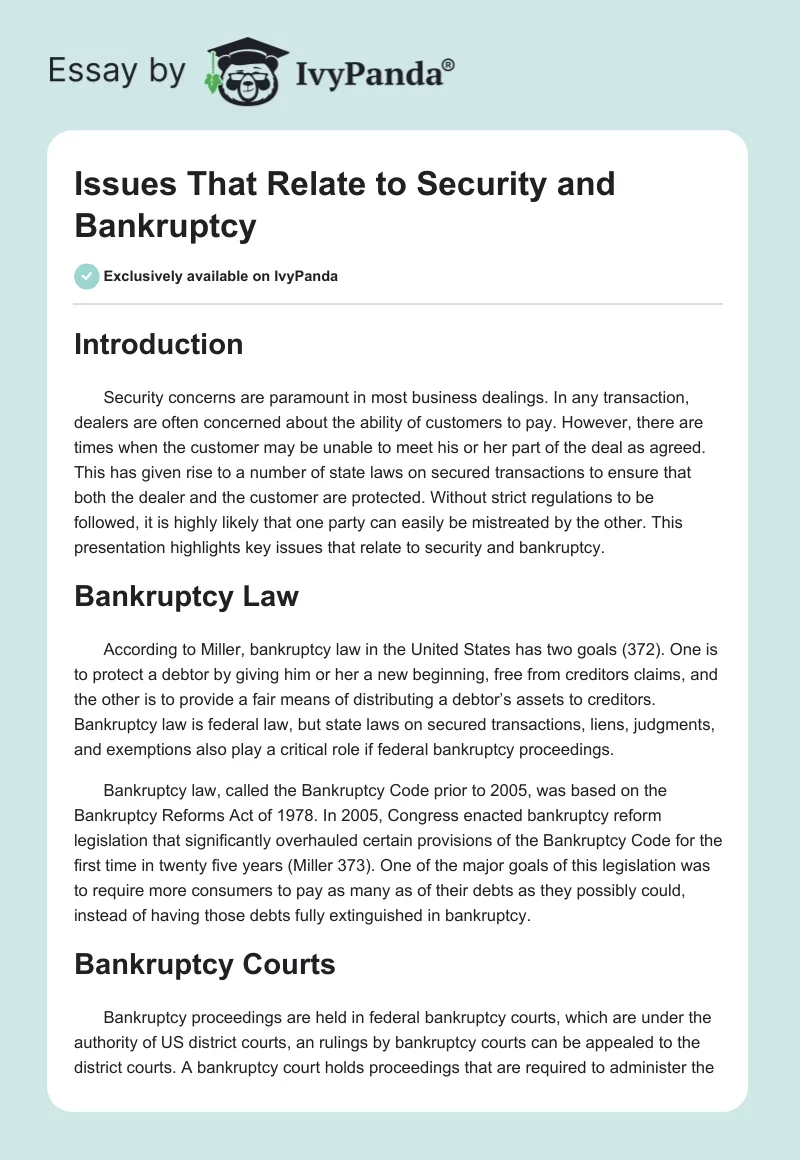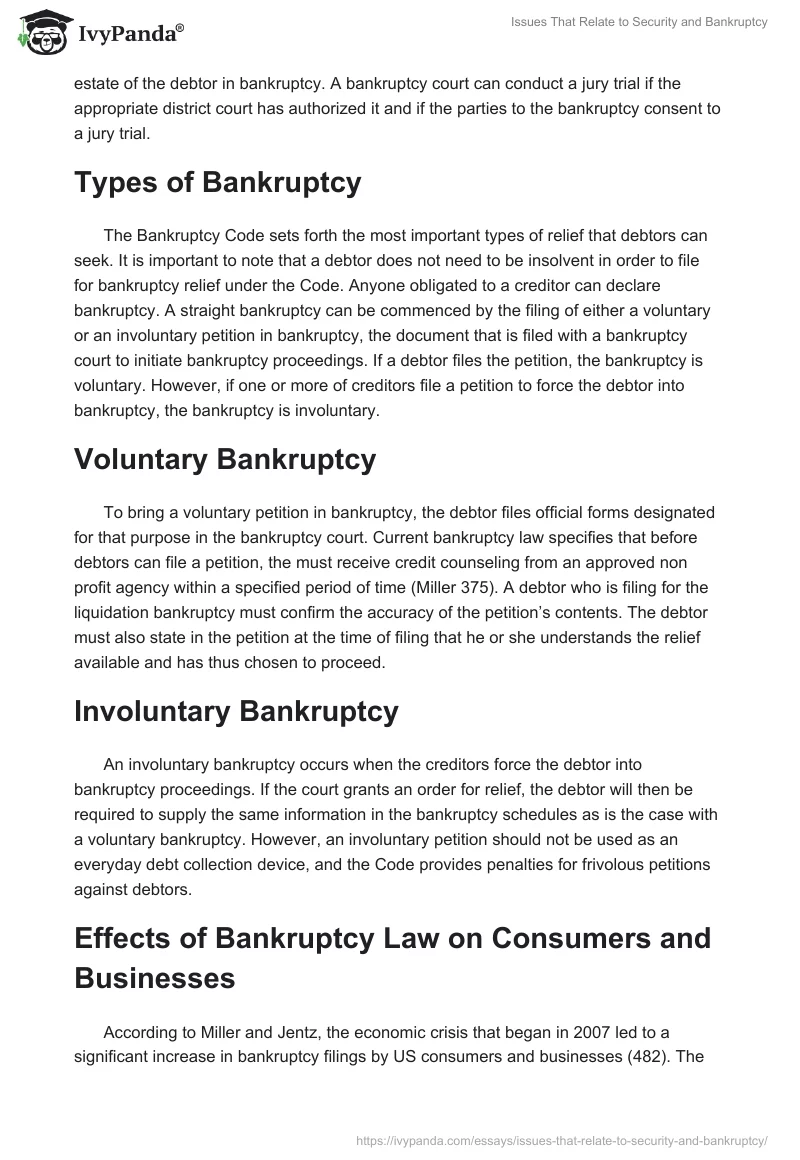Introduction
Security concerns are paramount in most business dealings. In any transaction, dealers are often concerned about the ability of customers to pay. However, there are times when the customer may be unable to meet his or her part of the deal as agreed. This has given rise to a number of state laws on secured transactions to ensure that both the dealer and the customer are protected. Without strict regulations to be followed, it is highly likely that one party can easily be mistreated by the other. This presentation highlights key issues that relate to security and bankruptcy.
Bankruptcy Law
According to Miller, bankruptcy law in the United States has two goals (372). One is to protect a debtor by giving him or her a new beginning, free from creditors claims, and the other is to provide a fair means of distributing a debtor’s assets to creditors. Bankruptcy law is federal law, but state laws on secured transactions, liens, judgments, and exemptions also play a critical role if federal bankruptcy proceedings.
Bankruptcy law, called the Bankruptcy Code prior to 2005, was based on the Bankruptcy Reforms Act of 1978. In 2005, Congress enacted bankruptcy reform legislation that significantly overhauled certain provisions of the Bankruptcy Code for the first time in twenty five years (Miller 373). One of the major goals of this legislation was to require more consumers to pay as many as of their debts as they possibly could, instead of having those debts fully extinguished in bankruptcy.
Bankruptcy Courts
Bankruptcy proceedings are held in federal bankruptcy courts, which are under the authority of US district courts, an rulings by bankruptcy courts can be appealed to the district courts. A bankruptcy court holds proceedings that are required to administer the estate of the debtor in bankruptcy. A bankruptcy court can conduct a jury trial if the appropriate district court has authorized it and if the parties to the bankruptcy consent to a jury trial.
Types of Bankruptcy
The Bankruptcy Code sets forth the most important types of relief that debtors can seek. It is important to note that a debtor does not need to be insolvent in order to file for bankruptcy relief under the Code. Anyone obligated to a creditor can declare bankruptcy. A straight bankruptcy can be commenced by the filing of either a voluntary or an involuntary petition in bankruptcy, the document that is filed with a bankruptcy court to initiate bankruptcy proceedings. If a debtor files the petition, the bankruptcy is voluntary. However, if one or more of creditors file a petition to force the debtor into bankruptcy, the bankruptcy is involuntary.
Voluntary Bankruptcy
To bring a voluntary petition in bankruptcy, the debtor files official forms designated for that purpose in the bankruptcy court. Current bankruptcy law specifies that before debtors can file a petition, the must receive credit counseling from an approved non profit agency within a specified period of time (Miller 375). A debtor who is filing for the liquidation bankruptcy must confirm the accuracy of the petition’s contents. The debtor must also state in the petition at the time of filing that he or she understands the relief available and has thus chosen to proceed.
Involuntary Bankruptcy
An involuntary bankruptcy occurs when the creditors force the debtor into bankruptcy proceedings. If the court grants an order for relief, the debtor will then be required to supply the same information in the bankruptcy schedules as is the case with a voluntary bankruptcy. However, an involuntary petition should not be used as an everyday debt collection device, and the Code provides penalties for frivolous petitions against debtors.
Effects of Bankruptcy Law on Consumers and Businesses
According to Miller and Jentz, the economic crisis that began in 2007 led to a significant increase in bankruptcy filings by US consumers and businesses (482). The filings continued to rise, and in the year, they had reached 30 per cent. In a typical month in 2009, about 100,000 consumers filed for bankruptcy protection. In the United States, bankruptcy is permitted under Article I, Section 8. This authorizes Congress to enact uniform laws on the subject of bankruptcies throughout the United States. Ostensibly, bankruptcy law can change the incentives facing consumers and can also affect the incentives of businesses that offer lending services (Miller and Jentz 483).
Bankruptcy Laws and Incentives Facing Consumers
Before the framing of the US Constitution, there were debtors’ prisons in the United States, and debtors who could not pay their debts were sometimes sent to these and other prisons. The threat of going to prison certainly caused consumers to borrow less and to make a great effort to repay what they owed. Today, debtors’ prisons are no longer in existence and consumers who are not able to pay their debts know that although they may be ruined if they have to file for bankruptcy, they will not go to prison.
It goes without that the easier and less costly it is for consumers to declare bankruptcy and efficiently start over with a clean slate, the more debt they will demand and the less they will worry about repaying their debtors. Indeed, one of the reasons why the bankruptcy reform law was enacted was to prevent abuse of the bankruptcy process. According to some people, it had become so easy for consumers to avoid paying their debts in full.
Bankruptcy Laws and Incentives of Businesses the Lend
Consumers typically obtain credits from banks, credit card companies, auto loan companies, finance companies, and major retailers. These lending entities end up charging a competitive interest because the market for consumer credit is highly competitive. The competitive interest rate includes a risk premium to cover the consumer debt that is never repaid. Consequently, the easier it is for consumers to file for bankruptcy and wipe out their debts, the higher the risk to the lenders (Mann and Roberts 25). In other words, the more forgiving the bankruptcy laws are, the more lending entities will charge consumers for credit.
Apparently, all government actions that change incentives lead to other changes in the economy. In this regard, laws that are more favorable to borrowers are by definition less favorable to lenders. This leads to higher market interest rates for loans.
Running a Business in Bankruptcy
When a company is in bankruptcy, court approval is not necessary for transactions in the ordinary course of business. However, notice to parties in interest and court approval are required prior to, among other things, using, leasing, or selling of property of the estate outside of business, borrowing money on a secured or super priority basis, rejecting or assuming prepetition contacts, and entering into new contracts or settlement agreements that affect property of the estate.
When a secured creditor’s collateral includes cash or cash proceeds of other collateral, the company in bankruptcy may not use the cash collateral unless the company adequately protects the creditor or obtains consent. If a debtor can not provide the secured creditor with the adequate protection or obtain the creditor’s consent, then the debtor can not use the cash collateral. Generally, this means that the debtor can not spend any cash and may be forced to business.
The Right to be relieved from Debt
Although most people in the United States do pay their debts, some people are unable to handle their debts (Goldman and Sigismond 602). To help consumers in this, Congress, pursuant to article I, section 8(4) of the US Constitution, passed the Federal Bankruptcy Act in 1898. This Act, which has been amended several times, primarily by the Bankruptcy Reform Act of 1978 and 2005, helps relieve a debtor of debt, allowing the debtor to a new economic life.
It allows unpaid creditors to receive the maximum amount from the debtor’s assets. As noted earlier, a person or corporation may be declared bankrupt under the Bankruptcy Reform Act by committing one or more acts of bankruptcy. Apart from voluntary and involuntary bankruptcies, another common form of bankruptcy is admitting in writing an inability to pay debts as they become due, a condition known as insolvency.
Works Cited
Goldman, Arnold and William Sigismond. Business Law: Principles and Practice, Mason, OH: Cengage Learning, 2010. Print.
Mann, Richard and Barry Roberts. Essentials of Business Law and the Legal Environment, Mason, OH: Cengage Learning, 2012. Print.
Miller, Roger. Fundamentals of Business Law: Excerpted Cases, Mason, OH: Cengage Learning, 2012. Print.
Miller, Roger and Gaylord Jentz. Business Law Today: The Essentials, Mason, OH: Cengage Learning, 2010. Print.


